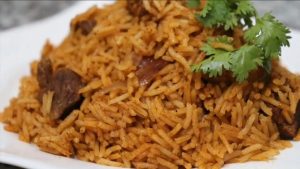8 May 2023 | Kenyan Recipes

Pilau is a spicy-heavy and aromatic rice, with beef pieces cooked as a one-pot dish. Pilau is also known as Pilaf in other regions. It is believed to have originated from The Middle East and then was adopted by the Coastal Swahili tribes through historical trading interactions. In the continental mainland, it is an occasional dish served during events and gatherings.
Ingredients
- 5 Cloves Whole,
- 6 Green Cardamons Pods,
- 4 Cinnamon Sticks,
- 3 Star Anise,
- 1Tsp Cumin Seeds Whole,
- 2 Cups Basmati Rice,
- 5 Black Pepper Corns,
- 1/4 Cup Vegetable Oil,
- 1 Large Onion-Sliced,
- 2Tbs Ginger-Garlic Paste,
- 500g Beef
Procedure
- Start by cutting your beef into slightly larger chunks as they will shrink upon cooking, and boil them in salted water till cooked and tender. Meanwhile, as your beef is cooking wash your rice till the water runs clear and soak it in water.
- Add oil to a saucepan, and turn on the heat to medium-high till the oil warms
- Cook your onions till golden brown for 3 minutes then add ginger-garlic paste and cook for a further minute
- Add your whole spices to the cooked onions and cook further for at least 2 minutes with the pot covered by a lid
- Add your drained cooked beef, adjust salt if desired, and add a splash of water to prevent burning. Cook for 5 minutes to allow the beef to infuse the flavors
- Drain water from your initially soaked rice and add the drained rice to your pot and combine with the beef pieces cook for a minute stirring continuously before adding 3.5 cups of water. Cover and simmer.
- Cook while observing till the water runs dry on the surface. Fluff up your pilau to combine everything then level up your rice dish in the pot
- Cover your pot with aluminum foil and turn off the heat to allow the residual steam to cook off the dish
- 10 minutes later, serve.
Serving

Your ready pilau should now be brown in color and strongly aromatic. The brown color is from the fried onions, the cooked beef, and the spice mix. The beef in pilau is normally overcooked, and the meat should fall off the bone.
Traditionally, pilau is served on a big tray with a side of kachumbari salad. Kachumbari is easy and basic; dice up 1 tomato and half red onion, about 2 tbs of fresh coriander leaves, a pinch of salt, and combine. If you love the heat you can add chopped-up red or green chilies or jalapenos.
After serving and before eating, take off the residual spices. Cinnamon sticks and Star Anise are easy to pick out but cloves, black peppercorns, and cardamons are a pain to take out since they are smaller in size.
Leftovers should be stored airtight and refrigerated for up to 3 days.
Notes
- Basmati rice is recommended but any long-grain rice will do as well. Because the grains stay separate and fluffy on cooking plus they absorb spices better due to the large surface area. Jasmine is a workable example of another long-grain rice
- Wash your rice thoroughly to remove the excess starch that would otherwise make your pilau clumpy and sticky. Soaking is optional but recommended as the rice absorbs water, it softens thus reducing cooking time. Softening also improves the texture making it fluffier and easy to absorb the flavors of spices used.
- For more flavor, skip adding water to your rice to cook it and instead use the beef stock from the earlier boiled beef, this will make your pilau more rich and increase the depth. But this is totally up to personal preference, if you prefer a simple and mild pilau use water.
- If you don’t like beef you can substitute it with lamb or chicken. However, note that chicken cooks faster and will be at a greater risk of overcooking. Lamb and mutton cook longer than beef as they are generally tougher.
- If you don’t have store-bought ginger garlic paste, you can make your own effortlessly by using 5 cloves of garlic and 1 inch of ginger. Crush them and add them to the dish, or using a mortar and pestle crush them together with 2 tbs of water. Use a food processor if that is what you have. You can even grate the ginger and smash the garlic then dice it thinly.
- You can use ready-prepacked and ground spice mix, pilau masala but it is normally frowned upon if you are going for the authentic pilau. Whole spices have a more complex flavor and aroma compared to the pre-ground mix. Ground Pilau Masala has its advantages, for example, you don’t get to worry about the whole spice in your dish that you might accidentally chew thus ruining your meal.
- For more flavor depth you can opt to toast your whole spices before cooking them. This facilitates the release of essential oils and reduces bitterness. You can alternatively soak the spices in water for like 30 minutes ahead of use. Soaking softens them up and brings out the full flavors upon cooking.
- For kachumbari, you can customize it by adding a drizzle of olive oil, and a dash of vinegar for that tangy kick. You can even add cucumbers but at this point, it won’t be kachumbari anymore but just a weird salad.
Nutritional Information
Amount per serving: Calories 536kcal
| Carbohydrates: 49g(37%) | Protein: 17g,(47%) | Fat: 9g, (15%) |
% is the percentage of calories of constituent macronutrients.
Micronutrients:
Vitamins: C, K, and B-complex
Minerals: Manganese, Calcium, Iron, Potassium, and Sodium
Pilau vs Biryani
Pilau and Biryani are so similar yet so different.
The Similarities
Both are made from long-grain rice and use almost identical spice combinations and fried onions. Both are made from meat and rice and served as mains and are spicy dishes.
The Differences
- Pilau originates from Persia, the Middle East while Biryani originates from India.
- Biryani is more complex in terms of flavor and texture and on a spiciness level
- Biryani constituents are cooked separately before being layered and steamed while pilau as mentioned is a one-pot dish and everything is cooked together.

